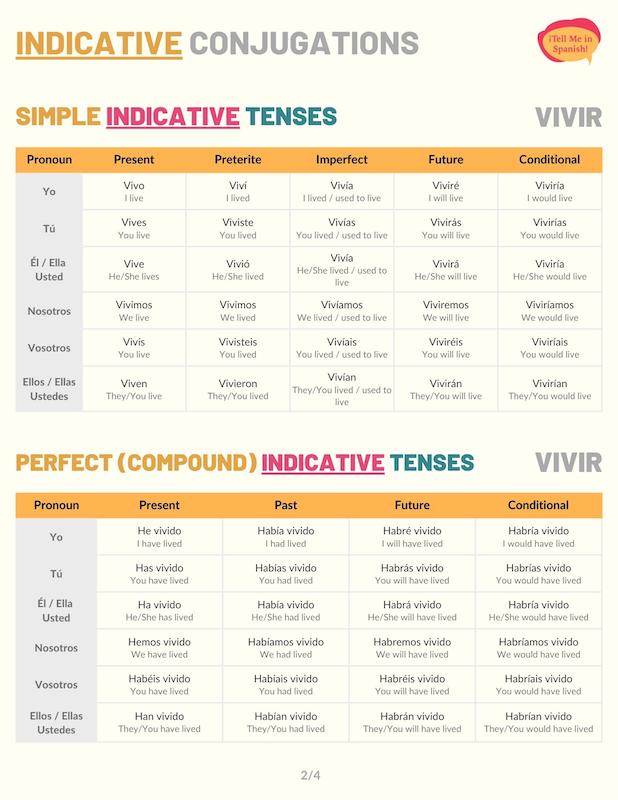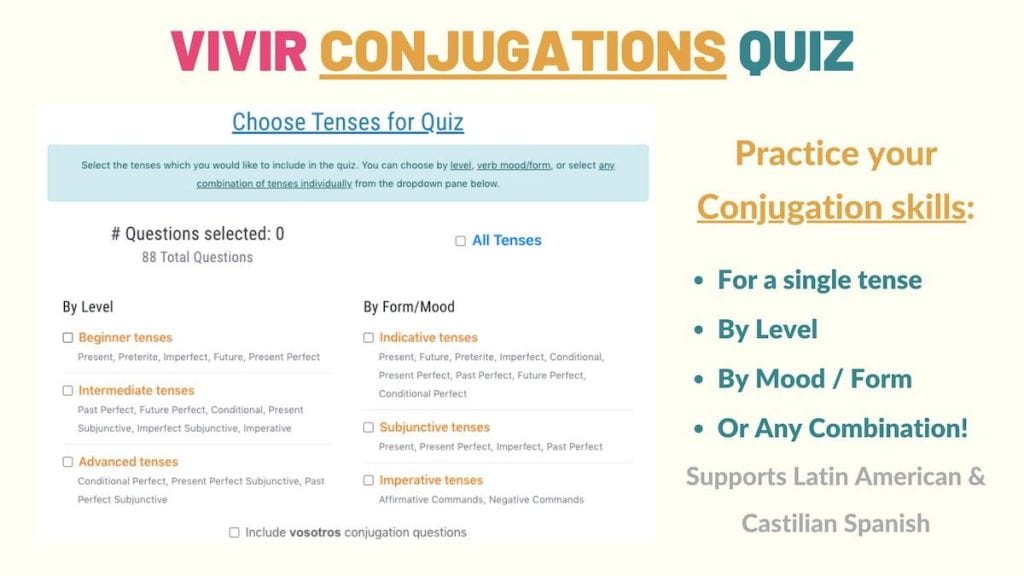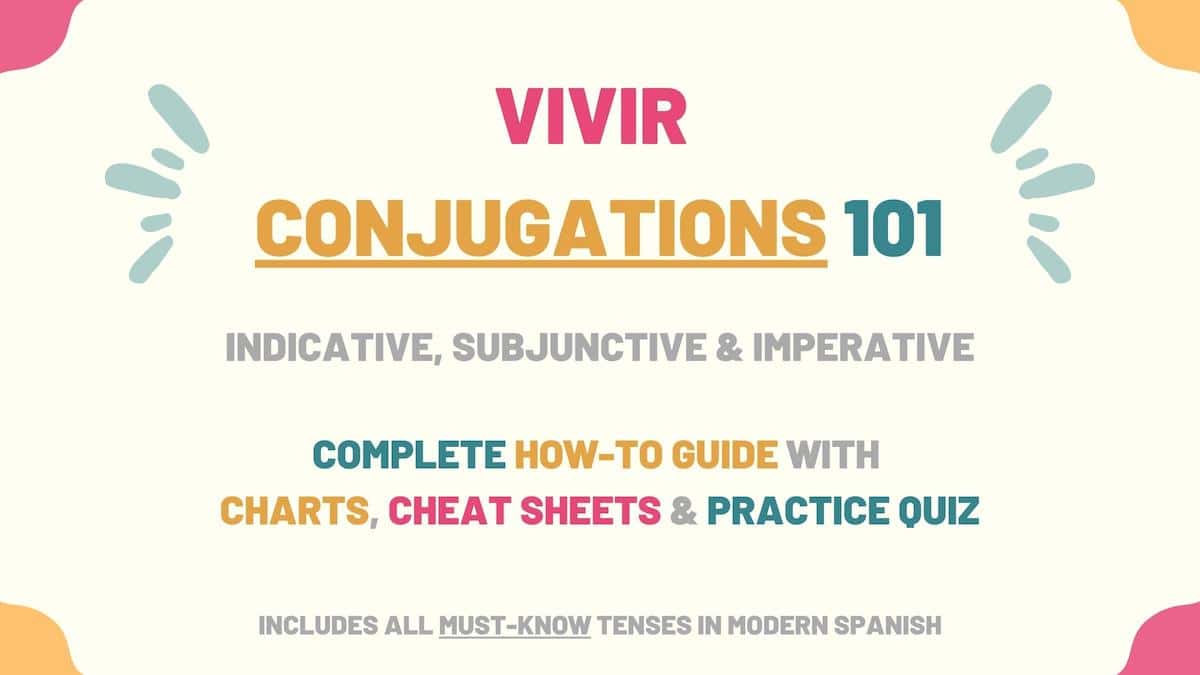Since it’s a regular verb in all tenses, vivir conjugation charts can help you get familiar with the regular endings for -IR verbs. So, in this guide, you’ll learn how to conjugate vivir in Spanish. Here’s what we’ll cover:
- Vivir Overview
- Indicative Tenses of Vivir Conjugations
- Subjunctive Tenses of Vivir Conjugations
- Imperative (Commands) of Vivir Conjugations
- Uses & Examples
- Download Vivir Conjugation Tables & Uses Cheat sheets
- Vivir Conjugation Practice Quiz
Overview of Vivir
| Verb Characteristic | Property |
|---|---|
| Verb Type | -IR |
| Irregular | No |
| Infinitive | Vivir |
| Gerund (Present Participle) Form | Viviendo |
| Past Participle Form | Vivido |
| Synonyms | Habitar, Residir, Subsistir |
Indicative Conjugations of Vivir
Present tense
The present tense conjugations of vivir are used to express the place where a person currently lives. For example: Nosotros vivimos en México.
| Person | Conjugation | Translation |
|---|---|---|
| Yo | Vivo | I live |
| Tú | Vives | You live |
| Él / Ella Usted | Vive | He/She lives You (formal) live |
| Nosotros | Vivimos | We live |
| Vosotros | Vivís | You live |
| Ellos / Ellas Ustedes | Viven | They live You (plural) live |
Preterite tense
Vivir preterite conjugations are all regular. Use the preterite tense forms of ‘vivir’ to explain where or with whom someone lived at a specific moment in the past. Yo viví con mis abuelos durante dos años.
| Person | Conjugation | Translation |
|---|---|---|
| Yo | Viví | I lived |
| Tú | Viviste | You lived |
| Él / Ella Usted | Vivió | He/She lived You (formal) lived |
| Nosotros | Vivimos | We lived |
| Vosotros | Vivisteis | You lived |
| Ellos / Ellas Ustedes | Vivieron | They lived You (plural) lived |
Imperfect tense
When conjugated to the past imperfect tense, vivir is used to talk about where a person used to live in the past. For instance: Cuando era niña, Samantha vivía con su abuela.
| Person | Conjugation | Translation |
|---|---|---|
| Yo | Vivía | I lived I used to live |
| Tú | Vivías | You lived You used to live |
| Él / Ella Usted | Vivía | He/She lived He/She used to live You (formal) lived You (formal) used to live |
| Nosotros | Vivíamos | We lived We used to live |
| Vosotros | Vivíais | You lived You used to live |
| Ellos / Ellas Ustedes | Vivían | They lived They used to live You (plural) lived You (plural) used to live |
Near future
The immediate future of ‘vivir’ communicates that a person is planning to live somewhere or with someone else soon in the future. For instance: No sé dónde vamos a vivir. This verb in the Spanish near future tense is formed with ir (present tense) + a + vivir and can be translated as “going to live”.
| Person | Conjugation | Translation |
|---|---|---|
| Yo | Voy a vivir | I’m going to live |
| Tú | Vas a vivir | You’re going to live |
| Él / Ella Usted | Va a vivir | He/She is going to live You (formal) are going to live |
| Nosotros | Vamos a vivir | We’re going to live |
| Vosotros | Vais a vivir | You’re going to live |
| Ellos / Ellas Ustedes | Van a vivir | They’re going to live You (plural) are going to live |
Future simple tense
Vivir future conjugations communicate that someone will live somewhere at some point in the future. For example: Algún día viviremos en París.
| Person | Conjugation | Translation |
|---|---|---|
| Yo | Viviré | I will live |
| Tú | Vivirás | You will live |
| Él / Ella Usted | Vivirá | He/She will live You (formal) will live |
| Nosotros | Viviremos | We will live |
| Vosotros | Viviréis | You (formal) will live |
| Ellos / Ellas Ustedes | Vivirán | They will live You (plural) will live |
Conditional tense
Use the conditional forms of ‘vivir’ to say that a person would live in a certain place or with someone else if some circumstances are met. This tense also allows you to make a hypothesis about where a person would live. Si tuviéramos dinero, viviríamos en una casa más grande.
| Person | Conjugation | Translation |
|---|---|---|
| Yo | Viviría | I would live |
| Tú | Vivirías | You would live |
| Él / Ella Usted | Viviría | He/She would live You (formal) would live |
| Nosotros | Viviríamos | We would live |
| Vosotros | Viviríais | You would live |
| Ellos / Ellas Ustedes | Vivirían | They would live You (plural) would live |
Present perfect tense
Haber in the present tense + vivido (past participle) is the formula of the Spanish present perfect tense. Use these ‘vivir’ conjugations to express that someone has or hasn’t lived somewhere. For instance: Janeth ha vivido aquí toda su vida.
| Person | Conjugation | Translation |
|---|---|---|
| Yo | He vivido | I have lived |
| Tú | Has vivido | You have lived |
| Él / Ella Usted | Ha vivido | He/She has lived You (formal) have lived |
| Nosotros | Hemos vivido | We have lived |
| Vosotros | Habéis vivido | You have lived |
| Ellos / Ellas Ustedes | Han vivido | They have lived You (plural) have lived |
Past perfect
Vivir conjugated to the past perfect tense expresses that someone had lived somewhere before some other reference point in the past. Nunca había vivido en el campo. To form the past perfect, use the imperfect form of ‘haber’ and the past participle form of ‘vivir’.
| Person | Conjugation | Translation |
|---|---|---|
| Yo | Había vivido | I had lived |
| Tú | Habías vivido | You had lived |
| Él / Ella Usted | Había vivido | He/She had lived You (formal) had lived |
| Nosotros | Habíamos vivido | We had lived |
| Vosotros | Habíais vivido | You had lived |
| Ellos / Ellas Ustedes | Habían vivido | They had lived You (plural) had lived |
Future perfect
Vivir to the future perfect tense expresses that someone will have lived by or before a certain time in the future. These conjugations are also used to express that something might have lived somewhere. For instance: ¿Dónde habrá vivido mi abuela?
| Person | Conjugation | Translation |
|---|---|---|
| Yo | Habré vivido | I will have lived |
| Tú | Habrás vivido | You will have lived |
| Él / Ella Usted | Habrá vivido | He/She will have lived You (formal) will have lived |
| Nosotros | Habremos vivido | We will have lived |
| Vosotros | Habréis vivido | You will have lived |
| Ellos / Ellas Ustedes | Habrán vivido | They will have lived You (plural) will have lived |
Conditional perfect
The conditional perfect conjugations of vivir are used to say that someone would have lived somewhere or with another person as long as a past condition had been met. These conjugations also allow you to make hypotheses in the past. For instance: Yo nunca habría vivido contigo.
| Person | Conjugation | Translation |
|---|---|---|
| Yo | Habría vivido | I would have lived |
| Tú | Habrías vivido | You would have lived |
| Él / Ella Usted | Habría vivido | He/She would have lived You (formal) would have lived |
| Nosotros | Habríamos vivido | We would have lived |
| Vosotros | Habríais vivido | You would have lived |
| Ellos / Ellas Ustedes | Habrían vivido | They would have lived You (plural) would have lived |
Progressive tenses
Use the progressive tenses of vivir to describe where someone is living at the moment of speaking. For example: Sonia y Juan están viviendo juntos.
| Progressive Tense | Formula | Translation Example |
|---|---|---|
| Present | Estar (present) + viviendo | I am living |
| Preterite | Estar (preterite) + viviendo | You were living |
| Imperfect | Estar (imperfect) + viviendo | He was living |
| Future | Estar (future) + viviendo | We will be living |
| Conditional | Estar (conditional) + viviendo | They would be living |
Vivir Subjunctive Conjugations
The Spanish subjunctive allows you to express wishes, doubt or hypothetical situations. Below are the vivir conjugation charts for the subjunctive tenses.
Present subjunctive
Vivir subjunctive conjugations allow you to express wishes or request something regarding a person’s living situation. For example: Quiero que vivas feliz.
| Person | Conjugation | Translation |
|---|---|---|
| Yo | Viva | I live |
| Tú | Vivas | You live |
| Él / Ella Usted | Viva | He/She lives You (formal) live |
| Nosotros | Vivamos | We live |
| Vosotros | Viváis | You live |
| Ellos / Ellas Ustedes | Vivan | They live You (plural) live |
Present perfect subjunctive
Haber in the present subjunctive + vivido is the formula to build the present perfect subjunctive of ‘vivir’. When using this tense, ‘vivir’ conveys uncertainty about where someone has lived. Dudo que Ulises haya vivido aquí todo este tiempo.
| Person | Conjugation | Translation |
|---|---|---|
| Yo | Haya vivido | I have lived |
| Tú | Hayas vivido | You have lived |
| Él / Ella Usted | Haya vivido | He/She has lived You (formal) have lived |
| Nosotros | Hayamos vivido | We have lived |
| Vosotros | Hayáis vivido | You have lived |
| Ellos / Ellas Ustedes | Hayan vivido | They have lived You (plural) have lived |
Imperfect subjunctive
Use the imperfect subjunctive conjugations of ‘vivir’ to refer to past suggestions, requests, wishes or expectations you had about a person’s living situation. Nos recomendaron que no viviéramos aquí.
The imperfect subjunctive has two conjugation models depending on which type of Spanish you’re using:
Latin American Spanish version
| Person | Conjugation | Translation |
|---|---|---|
| Yo | Viviera | I lived |
| Tú | Vivieras | You lived |
| Él / Ella Usted | Viviera | He/She lived You (formal) lived |
| Nosotros | Viviéramos | We lived |
| Ellos / Ellas Ustedes | Vivieran | They lived You (plural) lived |
Note: The conjugation chart above doesn’t include the conjugation for vosotros because this pronoun is not used in Latin American Spanish.
Castilian Spanish version
| Person | Conjugation | Translation |
|---|---|---|
| Yo | Viviese | I lived |
| Tú | Vivieses | You lived |
| Él / Ella Usted | Viviese | He/She lived You (formal) lived |
| Nosotros | Viviésemos | We lived |
| Vosotros | Vivieseis | You lived |
| Ellos / Ellas Ustedes | Viviesen | They lived You (plural) lived |
Past perfect subjunctive
In the past perfect subjunctive, vivir conveys that someone or something would have lived somewhere if a past circumstance was met. You can also use these conjugations to express regrets or hypothetical results if someone had lived in a certain place or with another person. For example: De haber podido, hubiera vivido en Cancún.
| Person | Conjugation | Translation |
|---|---|---|
| Yo | Hubiera vivido | I had lived |
| Tú | Hubieras vivido | You had lived |
| Él / Ella Usted | Hubiera vivido | He/She had lived You (formal) had lived |
| Nosotros | Hubiéramos vivido | We had lived |
| Vosotros | Hubierais vivido | You had lived |
| Ellos / Ellas Ustedes | Hubieran vivido | They had lived You (plural) had lived |
Vivir Imperative Conjugations
To tell people what to do or not to do, we use the Spanish imperative mood.
Affirmative commands
Use the affirmative imperative forms of ‘vivir’ to give instructions to someone about their living situation. For example: Vivid con alegría.
| Person | Conjugation | Translation |
|---|---|---|
| Tú | Vive | Live |
| Usted | Viva | Live |
| Vosotros | Vivid | Live |
| Ustedes | Vivan | Live |
Negative commands
To order people to not live in a certain place or with a particular person, use negative commands. For instance: No vivas aquí, es peligroso
| Person | Conjugation | Translation |
|---|---|---|
| Tú | No vivas | Don’t live |
| Usted | No viva | Don’t live |
| Vosotros | No viváis | Don’t live |
| Ustedes | No vivan | Don’t live |
Meanings of Vivir & Examples
Now that you’ve learned how to conjugate vivir in Spanish, you should check the examples below to see how to use this verb correctly.
Vivir is the direct translation of ‘to live’. You can use it with the preposition en to explain where someone lives or with con to express that you live with another person.
¿Cuánto llevas viviendo aquí?
How long have you been living here?
No sabía que vivías con Juan.
I didn’t know that you lived with Juan.
Si pudieras elegir, ¿dónde vivirías?
If you could choose, where would you live?
Take Note: Although it’s commonly used to build the present progressive (estar + gerund), the Spanish present participle of ‘vivir’ can also be used with seguir to talk about the amount of time you’ve lived in a place.
Download Vivir Conjugation Tables & Uses Cheat sheets

Click the button below to download the cheat sheets PDF I’ve assembled with all of the vivir conjugation charts, meanings, and uses so you can study them at your own pace.
Practice Quiz: Vivir Conjugation

Now that you’ve learned how to conjugate despertarse in Spanish, you can practice your skills conjugating a reflexive, stem-changing verb with the vivir conjugation practice quiz.



